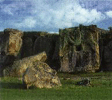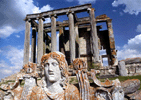The Interior Aegean
THE INTERIOR AEGEAN
THE INTERIOR AEGEAN REGION
Inland from the Aegean sea, the fertile soil has endured the passage of
many important early civilizations. Today, the remains of these cultures
can still be seen in the countryside as well as in the cities, towns and
villages. The more recent legacy of Ottoman rule is apparent in the well
preserved traditional Turkish domestic architecture and Ottoman mosques.
Leisure resorts have been built around the region's hot springs and can
accommodate those seeking the medicinal waters' pleasurable and
beneficial effects.
MANISA
 An attractive Aegean city, Manisa has preserved several splendid
examples of Seljuk and Ottoman architecture. The Sultan Mosque was built
early in the 16th century, endowed by Ayse Sultana, mother of Suleyman
the Magnificent. Every year in April, on the grounds of this mosque, a
festival is held celebrating Mesir Macunu, a sticky imperial elixir, that
reputedly cured the sultan's ailing mother. The 16th century Muradiye
Mosque was designed by the great architect Sinan and the adjacent
medrese, or theological college, today houses the Archaeological Museum.
September sees the annual Harvest Festival when the fruits of the
vineyards are brought in with great celebration. The region's numerous
vineyards produce grapes for wine making and dried fruit for export. South
of the city lies the Sipil Dagi National Park, home of the famous "crying
rock" of Niobe. If you travel to the northeast, you come to Gordes, a
pleasant town particularly known for its fine carpets.
An attractive Aegean city, Manisa has preserved several splendid
examples of Seljuk and Ottoman architecture. The Sultan Mosque was built
early in the 16th century, endowed by Ayse Sultana, mother of Suleyman
the Magnificent. Every year in April, on the grounds of this mosque, a
festival is held celebrating Mesir Macunu, a sticky imperial elixir, that
reputedly cured the sultan's ailing mother. The 16th century Muradiye
Mosque was designed by the great architect Sinan and the adjacent
medrese, or theological college, today houses the Archaeological Museum.
September sees the annual Harvest Festival when the fruits of the
vineyards are brought in with great celebration. The region's numerous
vineyards produce grapes for wine making and dried fruit for export. South
of the city lies the Sipil Dagi National Park, home of the famous "crying
rock" of Niobe. If you travel to the northeast, you come to Gordes, a
pleasant town particularly known for its fine carpets.
The ruins of ancient
Sart (Sardis), once the capital of the Lydian realm of Croesus, lie on the
Sart Cayi (Pactole River). The Temple of Artemis and a restored
gymnasium testify to the city's past splendor as does the important third
century synagogue.
USAK
Historically Usak was an important carpet weaving center, a role it
continues to play to this day. Tourists find the archaeological museum
informative and interesting.
AFYON
An inaccessible and imposing citadel dating to Byzantine times overlooks
this provincial city. The fortress guarded the route between the coast and
the interior of Anatolia. The Archaeological Museum and the War of
Independence Memorial reveal Afyon's place in history. Monumental
bas-reliefs, a legacy of the Phrygian kingdom, are carved into rock faces
on hills north of the city.  Aslantas is the largest; at Aslankaya lion reliefs
are engraved into the sides of the rock.
Aslantas is the largest; at Aslankaya lion reliefs
are engraved into the sides of the rock.
KUTAHYA
 The kilns of Kutahya produced exquisite ceramics in the 16th and 17th
centuries -- a craft which lives today. You can visit the workshops where
skilled artisan produce tiles, plates and bowls renowned for cobalt blue
patterns on a milky white background. Southwest of Kutahya, stands the
Roman town of Cavdarhisar (Aizanoi) of which a theater, stadium and the
Temple of Zeus remain.
Murat Mountain, in the same direction offers
camping facilities and hot springs amid delightful scenery. Near
Dumlupinar are the Baskomutan National Park and the War of Independence
memorials.
The kilns of Kutahya produced exquisite ceramics in the 16th and 17th
centuries -- a craft which lives today. You can visit the workshops where
skilled artisan produce tiles, plates and bowls renowned for cobalt blue
patterns on a milky white background. Southwest of Kutahya, stands the
Roman town of Cavdarhisar (Aizanoi) of which a theater, stadium and the
Temple of Zeus remain.
Murat Mountain, in the same direction offers
camping facilities and hot springs amid delightful scenery. Near
Dumlupinar are the Baskomutan National Park and the War of Independence
memorials.



![]() Aslantas is the largest; at Aslankaya lion reliefs
are engraved into the sides of the rock.
Aslantas is the largest; at Aslankaya lion reliefs
are engraved into the sides of the rock.
![]() The kilns of Kutahya produced exquisite ceramics in the 16th and 17th
centuries -- a craft which lives today. You can visit the workshops where
skilled artisan produce tiles, plates and bowls renowned for cobalt blue
patterns on a milky white background. Southwest of Kutahya, stands the
Roman town of Cavdarhisar (Aizanoi) of which a theater, stadium and the
Temple of Zeus remain.
Murat Mountain, in the same direction offers
camping facilities and hot springs amid delightful scenery. Near
Dumlupinar are the Baskomutan National Park and the War of Independence
memorials.
The kilns of Kutahya produced exquisite ceramics in the 16th and 17th
centuries -- a craft which lives today. You can visit the workshops where
skilled artisan produce tiles, plates and bowls renowned for cobalt blue
patterns on a milky white background. Southwest of Kutahya, stands the
Roman town of Cavdarhisar (Aizanoi) of which a theater, stadium and the
Temple of Zeus remain.
Murat Mountain, in the same direction offers
camping facilities and hot springs amid delightful scenery. Near
Dumlupinar are the Baskomutan National Park and the War of Independence
memorials.


